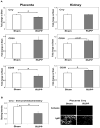Role of IgM and angiotensin II Type I receptor autoantibodies in local complement activation in placental ischemia-induced hypertension in the rat
- PMID: 27588825
- PMCID: PMC5056842
- DOI: 10.1016/j.molimm.2016.08.016
Role of IgM and angiotensin II Type I receptor autoantibodies in local complement activation in placental ischemia-induced hypertension in the rat
Abstract
Preeclampsia is characterized by development of hypertension during pregnancy and reduced placental perfusion. Previous studies in a rat model of placental ischemia-induced hypertension demonstrated that inhibiting complement activation attenuated increased maternal blood pressure with C3a and C5a identified as the important products of complement activation. Given that in other forms of ischemia both natural IgM and antigen antibody complexes initiate complement activation, we hypothesized that placental ischemia exposes neoepitopes recognized by IgM to cause local complement activation and hypertension. Alternatively, we postulated that autoantibody to angiotensin II Type 1 receptor (AT1-AA) interacts with AT1 receptors to cause complement activation. Since complement activation occurs in kidney and placenta in preeclampsia, we used immunohistochemistry to determine IgM deposition and local complement activation in each organ (C3 deposition), and quantitative real-time polymerase chain reaction (qRT-PCR) to quantitate mRNA for endogenous regulators of complement activation CD55, CD59 and Complement receptor 1-related gene/protein y (Crry). On gestation day (GD)14.5, timed pregnant Sprague Dawley rats underwent Sham surgery or placement of clips on inferior abdominal aorta and ovarian arteries to create placental ischemia using the reduced utero-placental perfusion pressure (RUPP) model. As previously reported, RUPP surgery increased mean arterial pressure and circulating C3a on GD19.5. In placenta, IgM and C3 deposition increased, whereas mRNA for complement regulators Crry and CD59 decreased along with Crry protein in RUPP compared to Sham treated animals. In kidney, IgM deposition increased in animals subjected to RUPP vs Sham surgery without a significant change in C3 deposition and coincident with an increase in mRNA for CD55 and CD59. The AT1 receptor antagonist losartan prevents placental ischemia-induced hypertension as well as AT1-AA interaction with AT1 receptors. However, losartan did not attenuate complement activation as measured by circulating C3a or placental C3 deposition. Importantly, our studies indicate that following placental ischemia, complement activation is not due to AT1-AA but is associated with IgM deposition. These studies suggest a role for natural antibodies interacting with placental ischemia-induced neoepitopes to activate complement and contribute to hypertension.
Keywords: Autoantibody; C3 deposition; Complement; Natural antibody; Preeclampsia; Pregnancy-induced hypertension.
Copyright © 2016 Elsevier Ltd. All rights reserved.
Conflict of interest statement
or Conflict of Interest The authors have no conflicts to report
Figures





References
-
- ACOG. Hypertension in pregnancy. Report of the American College of Obstetricians and Gynecologists’ Task Force on Hypertension in Pregnancy. Obstet Gynecol. 2013;122:1122–31. - PubMed
-
- Alexander BT, Kassab SE, Miller MT, Abram SR, Reckelhoff JF, Bennett WA, Granger JP. Reduced uterine perfusion pressure during pregnancy in the rat is associated with increases in arterial pressure and changes in renal nitric oxide. Hypertension. 2001a;37:1191–5. - PubMed
-
- Alexander BT, Rinewalt AN, Cockrell KL, Massey MB, Bennett WA, Granger JP. Endothelin type a receptor blockade attenuates the hypertension in response to chronic reductions in uterine perfusion pressure. Hypertension. 2001b;37:485–9. - PubMed
-
- Arnold JN, Wormald MR, Suter DM, Radcliffe CM, Harvey DJ, Dwek RA, Rudd PM, Sim RB. Human serum IgM glycosylation: identification of glycoforms that can bind to mannan-binding lectin. J Biol Chem. 2005;280:29080–7. - PubMed
-
- Austen WG, Jr, Zhang M, Chan R, Friend D, Hechtman HB, Carroll MC, Moore FD., Jr Murine hindlimb reperfusion injury can be initiated by a self-reactive monoclonal IgM. Surgery. 2004;136:401–6. - PubMed
Publication types
MeSH terms
Substances
Grants and funding
LinkOut - more resources
Full Text Sources
Other Literature Sources
Medical
Research Materials
Miscellaneous

